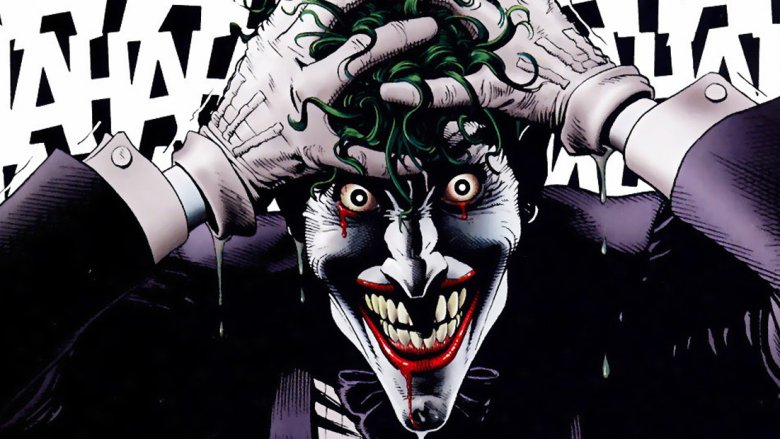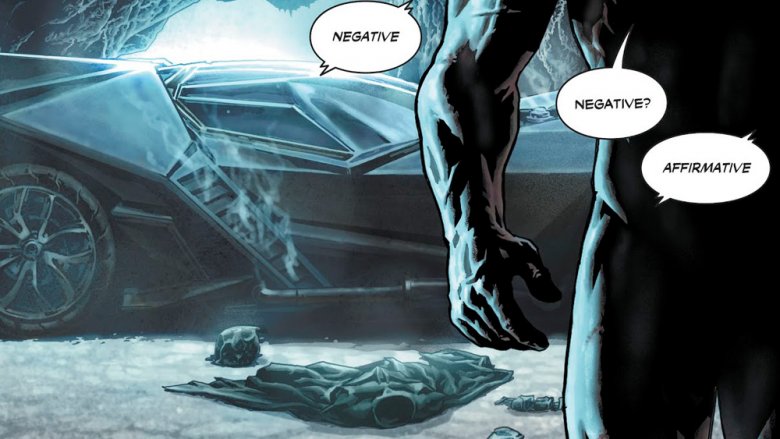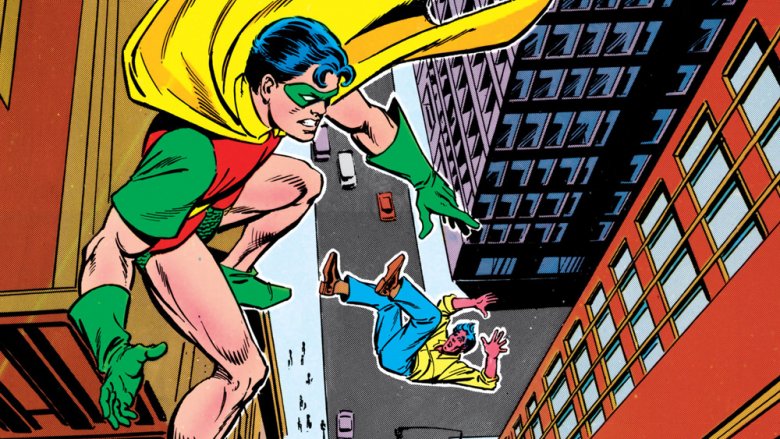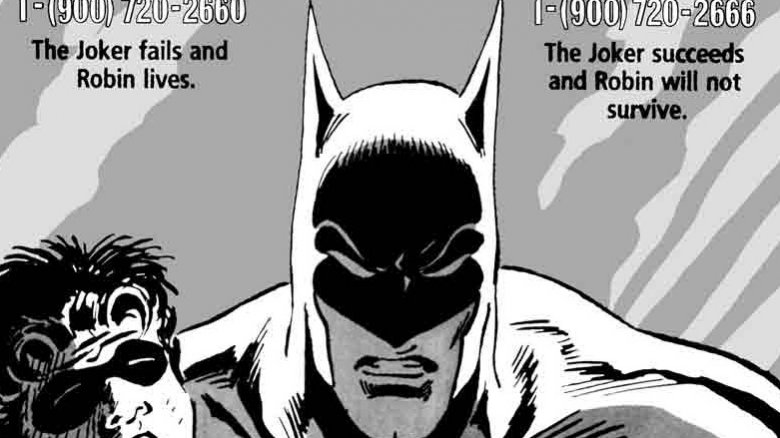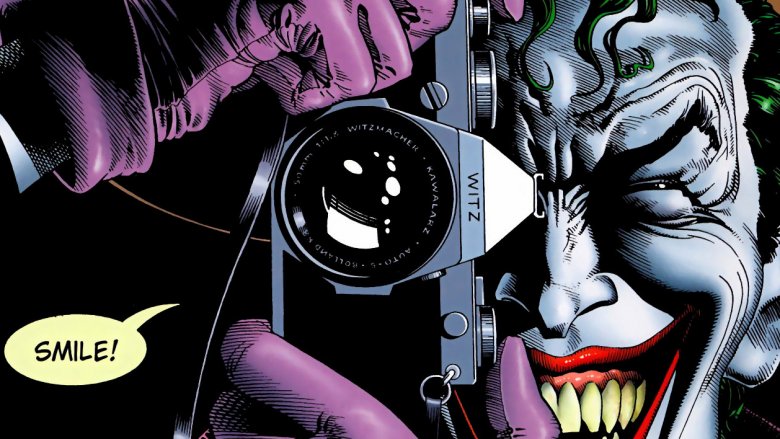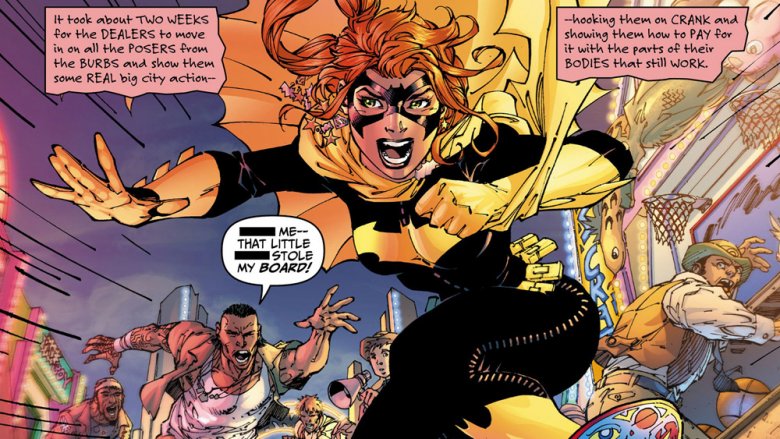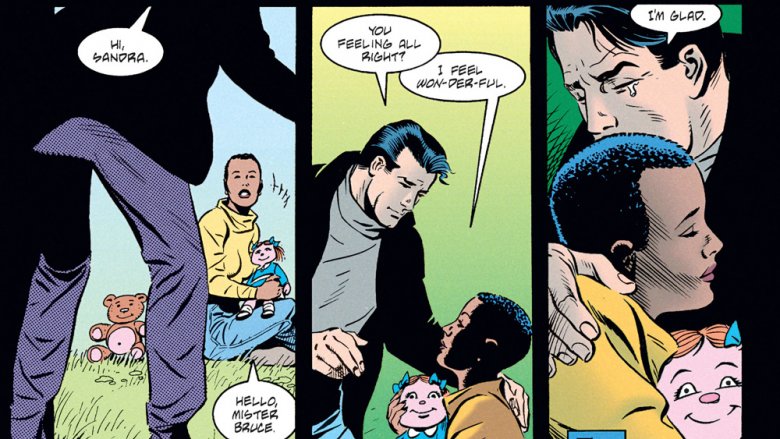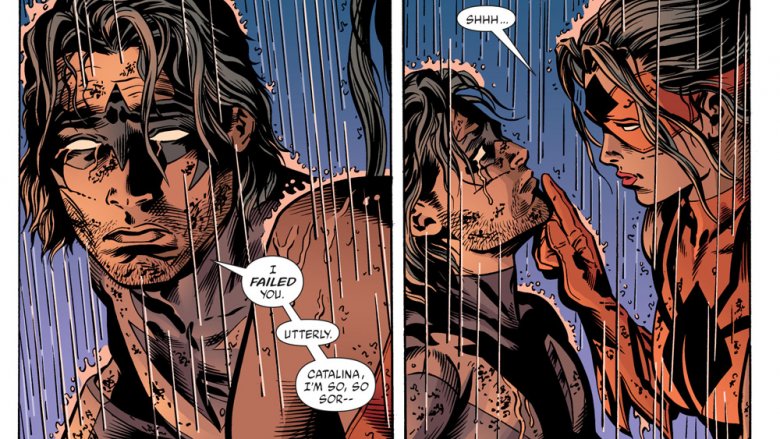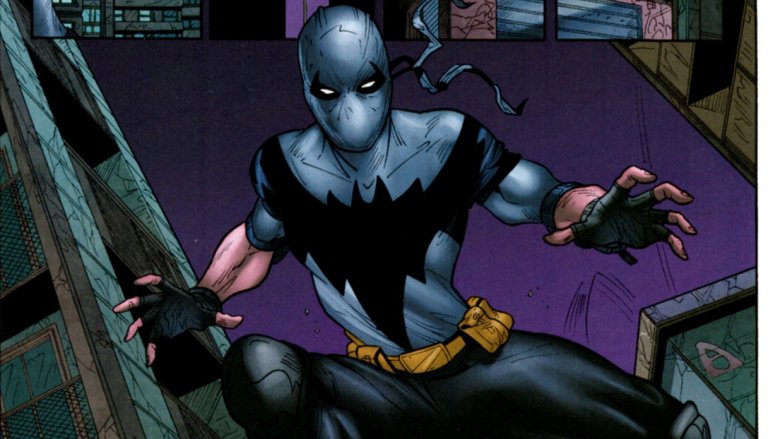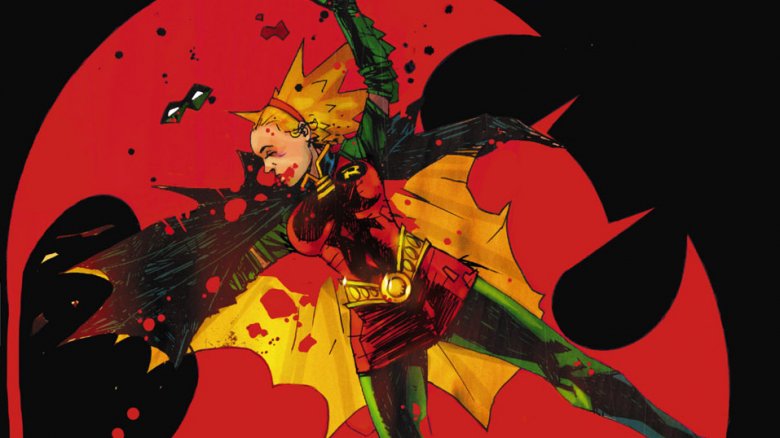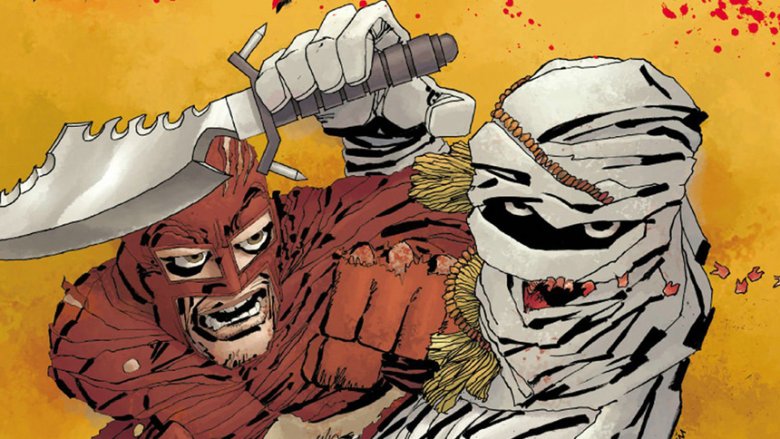The Most Controversial Moments In Batman History
As one of the world's most popular superheroes, Batman has starred in stories that touch on almost every genre you can imagine. Gritty crime stories, bizarre sci-fi, and even the occasional comedy have been published featuring the Caped Crusader, but not all of them have gone over well with the audience. It's definitely true that Batman's biggest problems tend to come from evil clowns, muscle-bound luchadors, and the occasional immortal bio-terrorist. Every now and then, though, real-world concerns manage to sneak into the four-color world of the page, and when they do, they can cause more trouble than the Joker, Bane, and Ra's al-Ghul combined.
From recalled issues to critical re-examinations, and all the way to some surprising instances of decidedly adult content, the Dark Knight has faced plenty of real-world controversy over the years. Here are the most notable issues prompting fan reaction that was divisive, dismissive, or downright disgusted.
Batman: Damned #1
Thanks to his long-lasting popularity over the years, fans have seen quite a bit of Batman. The launch of Brian Azzarello and Lee Bermejo's Batman: Damned in 2018, however, showed them a little more of the Caped Crusader than they might've been expecting, and gave a whole new meaning to the phrase "to the Bat-Poles."
The darker title was meant for DC's Black Label imprint of "Mature Readers" comics, but the psychologically driven murder mystery about Batman possibly murdering the Joker in cold blood wasn't what grabbed everyone's attention. Instead, most of the discussion about the first issue of Damned concerned a scene where Bruce Wayne returned to the Batcave, took off his costume, and walked around with his, uh, Batarang on display for everyone to see. Needless to say, plenty of readers were pretty shocked by the Dark Knight suddenly swerving into full frontal, and while the Wayne family jewels were kept in shadow, they were pretty clearly outlined in the book's first printing.
After this particular controversy swelled to an unexpected size, DC found it hard to ignore, and decided that maybe revealing Batman's Bat-Hog wasn't the best idea. Within a few days of the issue's premature release, DC made the hard decision that the nude scene would be removed from future printings, and adjusted the art in the digital version to keep the offending outline in shadow. Still, plenty of copies of the first printing made it to shelves, and the issue quickly became a sought-after collector's item for a very specific kind of collector. With that as its start, we can only imagine what surprises might be in store if this book runs another 68 issues.
Batman #424: The Diplomat's Son
No matter what kind of stories he starred in, Jason Todd was bound to be a controversial character. He was, after all, the second Robin, taking over the role in the '80s from Dick Grayson, who had been introduced over 40 years before and gone on to become one of DC's most popular characters. That may be why the original version of Jason was a carbon copy of Grayson, right down to an origin that made him a circus acrobat whose parents were murdered.
After the DC Universe was restructured in Crisis on Infinite Earths, however, the decision was made to give the new Robin a darker edge, including a new origin that made him a street kid recruited by Batman when he was trying to steal the hubcaps off the Batmobile. While Detective Comics stuck with stories that followed the traditional Batman/Robin dynamic, the Batman title saw Jason going in a much more violent direction than his predecessor. That came to a head in Batman #424, when Jason was confronted with a South American criminal named Felipe who abused his girlfriend until she committed suicide, but whose diplomatic immunity kept him from being arrested. While Batman was out of sight, Felipe plunged off a skyscraper balcony to his death, and when the Dark Knight asked Jason point-blank if he'd been pushed, Robin simply said "I guess I must've spooked him. He slipped."
The story was left purposefully ambiguous, but reader interpretation was that Jason had absolutely murdered a criminal who was untouchable within the law. Reaction was mixed, with the letters pages filling up with arguments on both sides of the issue, and the story was even seen as a justification for why Jason was killed off only a few months later. When Jason returned 20 years later as the Red Hood, his more murderous nature was definitely a part of him, but some readers interpreted this story as the foundation of a more feminist version of the character.
Batman 428: A Death in the Family
If Jason Todd's life was controversial, his death was even more divisive. Not only were readers debating whether or not he should stay in the comics, over 10,000 of them were willing to pay for the privilege of deciding the issue for themselves.
In 1988, the four-part "Death in the Family" story arc launched in the pages of Batman #426, and came complete with a gimmick — well, several gimmicks, actually, including a truly bizarre twist halfway through where the Joker became the official Iranian ambassador to the United Nations. The big one, though, was that after the Joker brutally beat Robin with a crowbar and blew him up with a bomb, readers were allowed to vote through a telephone poll on whether or not he'd survive.
When the votes were all tallied, Jason was dead, but it wasn't a landslide victory for the Joker. Of the 10,614 votes cast, 5,343 were in favor of Robin being killed off, sealing Jason's fate by a margin of only 72 votes. Any readers who might've been worried about Batman being permanently free of a sidekick shouldn't have worried, though. By the end of 1989, Tim Drake would be debuting as the all-new Robin, and has managed to avoid any fateful encounters with a crowbar in the years since.
Batman: The Killing Joke
When it was originally released in 1988, and for decades after, Alan Moore and Brian Bolland's Batman: The Killing Joke was regarded as a cornerstone of the Batman mythology. Its ramifications were seen directly on the page for years, and even today, its origin for the Joker remains one of the most influential stories in comics history. Unfortunately, its treatment of Barbara Gordon, better known to readers as the original Batgirl, was also a lasting consequence.
As time went on, a critical re-examination heavily criticized the story for the plot point of Barbara Gordon being shot and assaulted by the Joker, ending her superheroic career as Batgirl. A big part of the problem came from the fact that Barbara herself was almost incidental to the violence, with her suffering used to torture her father and Batman. To make matters worse, Moore himself mentioned regretting the story, calling it "clumsy, misjudged, and of no real human importance" in a 2000 interview, and going on to bluntly state "I don't think it's a very good book." In 2006, he revealed that editor Len Wein's reaction when he pitched his plans for Barbara Gordon involved saying it was okay to "cripple" her, then using a disparaging term to describe the superheroine.
All of this has led to an ongoing debate over whether Killing Joke did more harm than good to the Batman mythos. It was adapted for an animated film in 2016 and it's still touted as a classic by DC — and by many readers — but many of its lasting effects have been undone in the years since. After returning as a super-hacker called Oracle, Barbara Gordon once again took on the role of Batgirl in 2011.
All Star Batman and Robin the Boy Wonder #10
Pretty much everything that happened for the duration of Frank Miller and Jim Lee's unfinished run on All Star Batman was controversial, including an overwrought scene of Batman and Black Canary hooking up on the docks ("we keep our masks on. It's better that way"), a multi-issue sequence of Batman kidnapping young Dick Grayson and forcing him to eat rats in the Batcave, and, weirdly enough, a scene where Batman and Robin painted an entire room and themselves bright yellow so that they could beat up Green Lantern. The moment that actually got the comic recalled by DC, however, wasn't an intentional plot point. It was a lettering error.
In the book's 10th issue, Batgirl made her appearance, slugging it out with some drug dealers who had a few less-than-kind words for her — words that you don't usually see in comic books. Needless to say, they were censored by black bars, but to get the spacing in the word balloons right, the offensive language was actually lettered into the comic, with the black bars added over them. The problem? When the issue hit print, it turned out that the censor bars weren't as opaque as they should've been. They were there, but the words beneath them were clearly visible.
The end result? A Batman comic where a 15 year-old Batgirl was being called one of the most offensive things you could call her, at least here in America, which did not go over well. DC caught the error before the book hit shelves, but it had already been sent to retailers. They were asked to return the misprinted comics so they could be replaced, but a few of them, of course, snuck out anyway. Perhaps coincidentally, All Star Batman never made it to #11.
Batman: Legends of the Dark Knight #61
Not all controversial comics feature offensive language, full frontal nudity, or extreme violence. Some of them spark debate and concern over their contents through pure comic book weirdness, like the one that detailed the sad and nearly incomprehensible fate of Shondra Kinsolving.
Many readers are familiar with "Knightfall," the 1993 epic that saw Batman taking on Bane, a supervillain who wore the Dark Knight down by breaking out every villain from Arkham Asylum, and then broke his back to finish the job. A world that features Lazarus Pits, cybernetic implants, and Amazonian Healing Rays offered creators plenty of options for how they'd eventually return Bruce Wayne to the cape and cowl, but instead of taking one of those, the people behind the Batman books decided to go with another option. It turned out that Bruce's physical therapist and would-be lover, Shondra Kinsolving, had psychic healing powers that allowed her to make Batman's spine as good as new.
Unfortunately, the use of her powers and a hypnotic drug caused her mind to permanently regress to a childlike state. Once he was fully recovered from his injuries, Bruce bought her an island estate, staffed it with "the best medical help I could find," and then proceeded to never mention her again. Batman's love interests have a mortality rate only slightly better than James Bond's, but even among a list of female characters killed off to advance a storyline, Shondra sticks out as a truly bizarre entry.
Nightwing #93
Since the 1980s, sexual assault has become an unfortunately common trope in the superhero genre, and one of the most egregious examples came in 2004, in the pages of Nightwing.
In a story by writer Devin Grayson and the art team of Patrick Zircher and Andy Owens, Dick Grayson — the former Robin who moved on to his own title in the '90s — was confronted by by Blockbuster, who had discovered Nightwing's secret identity and then promised to continue murdering everyone he loved. Confronted with that, Nightwing seemingly allowed another costumed hero that he'd been mentoring, the Tarantula, to shoot Blockbuster in the head in front of him. Traumatized by the experience and literally covered in blood from a death he'd failed to prevent, Nightwing ran to the roof in shock, with Tarantula following and sexually assaulting him.
The incident proved to be wildly controversial among readers.Ten years after it was originally published, Devin Grayson apologized for the story in an interview, saying, "By the time I realized the severity of the mistake and how harmful it might have been to actual survivors of sexual abuse and assault (myself included), I had run out of time to make it right. I'm not sure I could have made it right, mind you, but I did at least have the intention of bringing the story back around to it so that the act didn't exist completely devoid of consequence or analysis. But it does, and I regret that more deeply than I can say."
Batman Annual #28: Nightrunner
In 2011, the Batman franchise expanded through a storyline that involved Batman Incorporated. Basically, after revealing himself as the money behind Batman and inspired by the events of the Silver Age "Batmen of All Nations" story, Bruce Wayne set about recruiting an entire international team of Batmen from various countries. A Japanese hero named Mr. Unknown, for instance, was recruited to become the Batman of Japan, complete with a Kamen Rider-inspired outfit and a Batmobile that bore a suspicious resemblance to Speed Racer's Mach 5.
A story that ran through Detective Comics Annual #11 and Batman Annual #28, however, proved to be a little more divisive than a few of the other International Batmen. In that story, a Parisian hero named Nightrunner was recruited as the Batman of France. As his name implies, he does a lot of running at night, specifically using parkour as a crime-fighting tool. Also, he was portrayed as a French-Algerian Muslim, and the phrase "Muslim Batman" set off a particularly unpleasant reaction from conservatives.
The controversy followed hot on the heels of a Superman story that was allegedly axed for reintroducing a Middle Eastern hero previously known as Sinbad as a Superman-inspired hero called Sharif. Unlike that issue, however, Nightrunner's appearance and status as France's resident Batman were published and remained canonical, although he hasn't made many notable appearances in the years since.
War Games
It's an unwritten rule in the world of comic books that when a massive, multi-issue crossover takes place, at least one character is going to wind up dead — and it's usually someone who's close enough to the main characters to matter, but not so notable that their death is going to derail the title. In 2004, Stephanie Brown found herself on that list of expendable characters, and wound up causing an uproar among fans that would last for years.
Originally introduced as the Spoiler, the daughter of a relatively obscure Riddler knockoff called the Cluemaster, Stephanie was mostly known as a supporting character in the pages of Robin. Eventually, however, she briefly became Batman's sidekick, becoming the first (and only) canonical female Robin. All that changed with a story arc called "War Games," where she inadvertently kicked off a massive gang war in Gotham City with plenty of casualties, including Stephanie herself, who was tortured to death by the villain Black Mask. Things only got worse in the story's aftermath, when it was revealed that Dr. Leslie Thompkins, a longtime Batman supporting character who served as something of a mother figure for the Dark Knight, had allowed Stephanie to die in order to teach Batman a lesson about putting children in danger.
There was a long-running outcry from fans, including cosplayers dressed as Spoiler demanding answers from DC creators at conventions. The general attitude was that Stephanie deserved better — or at least a Jason Todd-style memorial in the Batcave — but eventually, the story was retconned with the reveal that she'd never actually died. Instead, she returned for a tenure as the all-new Batgirl, and eventually returned to her original identity as the Spoiler once the DC Universe was rebooted yet again.
Holy Terror
Sometimes, a comic book can be so controversial that it never gets released, or is recalled by the publisher, in order to keep it from damaging its characters' reputations. Holy Terror, on the other hand, is the rare comic that was so controversial that it was released without being associated with its lead character at all.
Originally announced in 2006 as Holy Terror, Batman!, the story was meant to be what writer/artist Frank Miller called a story where "Batman kicks Al-Qaeda's ass," justifying the premise by pointing out that Captain America was punching the real-life Hitler rather than a fictional supervillain on the cover of his first appearance. As the story went through years of development, though, it turned out that DC wouldn't be publishing it as a Batman story, or even publishing it at all. According to Miller himself, it was his decision that came as a result of realizing as he was working that it just "was not a Batman story," but there were of course plenty of rumors to the effect that DC had canned the project after seeing finished pages.
The hardcover graphic novel wound up being published by a division of Legendary Films and starred the Fixer, who was essentially Batman without the pointy ears. After witnessing a massive terrorist attack on Definitely Not Gotham City, the Fixer went on a quest to punish those responsible. True to Miller's word, the story was propaganda, and included scenes based on the idea that any Muslim could be a secret terrorist sleeper agent. It also veered into the realm of the cartoonishly surreal, and was referred to by critics as "one of the most appalling, offensive and vindictive comics of all time."
